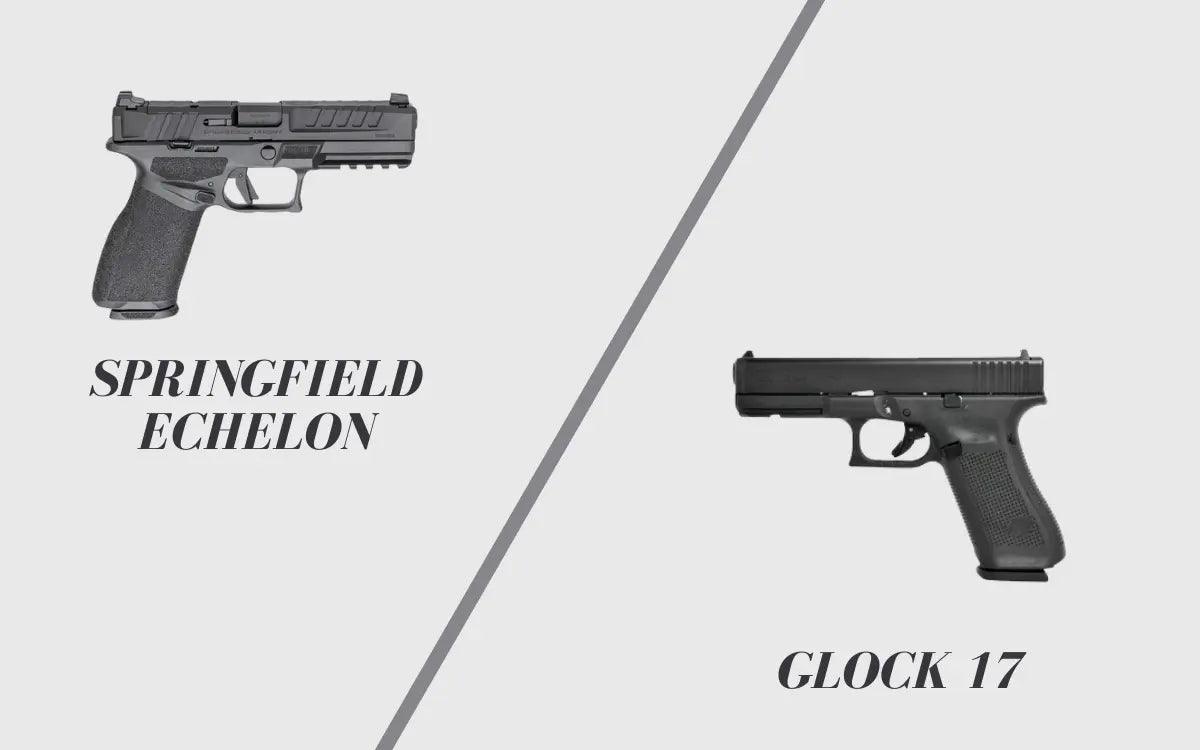The Clock 17 has been the top choice for full-size, striker-fired pistols with lightweight polymer frames. Its dominance has remained unquestioned for the last four decades. However, HS Product in Croatia is trying to create a solid space beside the Glock for its newest offering, Springfield Echelon. The 9mm, striker-fired, polymer-frame pistol has many modern features that overlap and contrast with the G17. This makes it the right time for a detailed comparison of Springfield Echelon vs Glock 17.
Springfield Echelon Vs. Glock 17 – Dimensions and Specs
The full-sized handguns are designed for a range of scenarios that professional shooters, law enforcement professionals, and gun owners find themselves in. Let’s review their major specs.
|
Spec |
Springfield Echelon |
Gen 5 Glock 17 |
|
Length (in inches) |
8 |
7.95 |
|
Height (in inches) |
5.5 |
5.47 |
|
Width (in inches) |
1.3 |
1.34 |
|
Weight (in oz.) |
23.9 |
25.08 |
|
Barrel length (in inches) |
4.5 |
4.49 |
|
Capacity |
17+1 rounds |
17+1 rounds |
|
Grip material |
Polymer with Adaptive Grip Texture |
High-strength polymer |
|
Trigger |
Striker-fired |
Striker-fired |
|
Caliber |
9mm |
9mm |
|
Optics system |
Direct mount VIS without adapter |
MOS models use adapter plates |
|
Trigger weight (in lbs) |
5.6 |
5.5 |
|
Aftermarket support |
Limited, but growing |
Extensive |
|
Price |
Between $679–$719 |
Between $620–$745 |
|
Ease of maintenance |
Simple |
Simple |
Springfield Echelon vs Glock 17 - Ergonomics
Ergonomically, Echelon is better than the Glock 17. Its thinner and more contoured grip has a wide appeal over the ''blocky" G17. The Echelon’s grip narrows toward the top and flares at the bottom. It leads to a safe and natural hold for a range of hand sizes. The enlarged trigger guard that is undercut and prominent rear beavertail allows for a higher and more comfortable grip.
The latest version of the Glock 17 is designed to be more ergonomic, with features like the absence of finger grooves and a pebble-textured grip. Still, it retains a boxy profile with straight contours. Also, while the Gen 5 G17 does offer interchangeable backstraps, it does not have the complete modularity of the Echelon’s Central Operating Group. This feature lets you swap the pistol between two distinct grip modules.
Differences in Controls and Safety
Both pistols have a minimalist approach to control. They don't have manual safety and depend on passive safety mechanisms like slide release/stop, magazine release, and trigger. The controls on both guns are ambidextrous. In the Echelon, the magazine release and slide lock are there on both sides of the gun. It has a flat-faced trigger that has a short reach to access. To cater to shooters with big hands or those wearing gloves, it has an oversized trigger guard.
The G17 Gen 5 has a reversible enlarged magazine catch, which you can change. It has an ambidextrous slide stop lever for both left and right-handed shooters. The magazine release can be reversed according to your preferred hand. The Glock 17 uses GLOCK's patented Safe Action System. It consists of three passive, automatic safeties: trigger safety, firing pin safety, and drop safety, which start and stop without manual intervention. This is a reliable safety mechanism.
Differences in Optics Mounting System
It's interesting to compare Springfield Echelon vs Glock 17 with regards to the optics mounting system. The Echelon has the VIS or the variable interface system, which is an innovative optic mounting system. Many different optics can be mounted to the Echelon. You will find that the gun's slide has many holes to accommodate screws for various footprints.
A set of pins, whose placement depends on optics, function as recoil bosses. Their placement varies, depending on the optics. No plates are in this mounting system. Also, your optic sits lower compared to the Modular Optics System (MOS) that uses adapter plates in the Glock 17. This results in an improved sight picture. The MOS requires the correct plate for each optic, which is not the case with VIS. Both these systems support most major red dots.
Variations in Modularity
Both pistols excel in being modular guns. The modularity of the G17 comes from its simple design, which allows for the swapping of different parts. The serialized part or the frame itself is not modular, and the pistol is trusted for its vast aftermarket support. You can customize almost anything, be it the trigger, sights, barrel, or slide.
Echelon does not have wide aftermarket support. However, it is designed around the impressive Central Operating Group (COG). COG is a serialized chassis that you can remove and position into different grip modules. This facilitates a lot of modularity and the ability to customize the pistol. You can also swap the grip based on your preference for size and texture.
Slide Serrations
The most remarkable difference when comparing Springfield Echelon vs Glock 17 is the serrations on the slide. While the G17 has front serrations, Echelon raises the bar with really deep serrations that let shooters dig in when manipulating the slide. There are tiny wings at the rear of the slide to make it convenient for shooters to manipulate the slide with an optic mount.
In the G17, front serrations provide an extra tactile surface for you to obtain positive traction even when your hands are sweaty. The front serrations also make it easier to manipulate a slide with an optic. The only difference is that the serrations in the Glock are less deep and aggressive than in Echelon, which makes a huge difference in the handling of slides by people with varied hand strengths.
Springfield Echelon vs Glock 17 - Accuracy
Both guns are reasonably accurate at the range. However, the adaptive grip texture, trigger, optics cut, and deep serrations in the Echelon can impact accuracy for the better. Still, the mechanical accuracy of these pistols is almost the same. It exceeds the practical ability of most shooters at defensive distances, which range between 7–25 yards.
The G17 and Echelon can engage targets with good speed and precision, and there are marginal variations in group size. These differences are largely an outcome of the experience and skills of the shooters themselves. You may think that Echelon's slightly longer barrel and weight make it way more accurate than the Glock, but the difference is minute.
Comparison of Reliability
The reliability of both pistols is flawless. Their ability to withstand abuse and still operate without any malfunction is impressive. You can use the broadest range of 9mm ammunition and still find these guns working fine. The latest Gen 5 Glock 17 is more reliable than the Gen 3 and 4 versions due to refinements in its design. These include an improved, lightweight trigger, ambidextrous slide release, absence of finger grooves, and flared magazine wells. Similarly, great ergonomics and compatibility with wide-ranging ammunition make Echelon highly dependable.
Final Verdict
The Glock 17's dominance in the polymer-framer striker-fired world has been prominent. However, a comparison with Springfield Echelon shows that it stands face-to-face with its contender. Echelon's chassis system, modularity, optic system, slim grip, and trigger press make it on par with the Glock 17, if not better than that. Still, it does not mean that Glock 17 owners should run to grab this new entrant in the market. The Glock's simplicity and reliability are more than satisfactory. If you combine this with the limitless options for customizing the gun, you have an unbeatable pistol.






Leave a comment (all fields required)